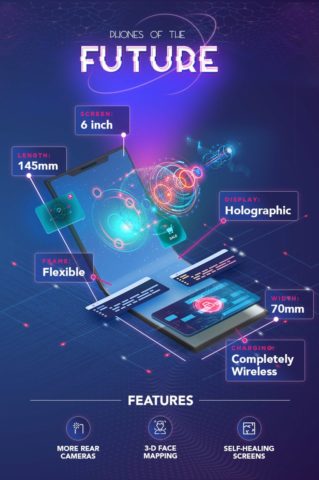According to a research study from UK reseller Buymobiles, we can expect a huge shift toward eco-friendly mobile phones over the next 10-20 years.
Of course, Apple already leads many of its rivals in terms of its care for the environment, with the latest iPhones made of 98% recycled rare earth materials and 100% of its global operations running on renewable power. The company is increasingly encouraging suppliers to do the same, and meanwhile it also allocates billions of dollars in Green Bonds to fund environmental initiatives.
But this latest study suggests consumer demand for carbon-neutral phones is shifting the entire industry in that direction, albeit slowly.
Perhaps the most interesting predictions form part of a “phone of the future” mockup, seen below. It suggests that in a decade or so, we’ll all be walking around with completely wireless, completely flexible phones with self-healing holographic displays.
Honestly, it’s not as far-fetched as it looks at first. Most of the features seen in this graphic – like more rear camera and 3D face mapping – already exist in the latest iPhones, while it’s long been rumored that Apple hopes to remove all ports and go fully wireless as soon as feasibly possible.
Here’s more from the report:
Consumer demand for more sustainable packaging has grown by 24% in 2021 according to search trend data, with brands considering alternatives to current plastic heavy packaging, such as using soy ink and more recycled materials.
Another search term that increased significantly this year was ‘eco mobiles’ rising 25%.
This has clearly made an impact as several leading network providers have also signed up to a new eco-rating scheme that will measure devices on durability, repairability, recyclability, climate efficiency and resource efficiency.
The research went on to look at more generic features that brands are working to implement in future models and found a number of them, such as no charging ports and self-healing screens, strongly focussed on the device’s durability.
Fewer repairs to areas of mobiles that are often more problematic, such as screens and charging ports, will automatically reduce a device’s carbon footprint.
Eden Cheng, founder of US-based FindPeopleFast, commented on the research and said, “Shifting towards eco-friendly smartphone practices is not an easy move to make as there are a couple of hurdles in the process. For instance, one has to figure out a way to extract rare earth elements, the necessity for smartphone manufacturing, without causing any harm to the earth.
“One other area where a lot of work needs to be done is offering solar-based or air-based charging facilities. Energous, a company specialising in wireless charging, is working towards this direction and the prototype is ready as well. But lots of improvement is needed in this area before the technology reaches the customers’ hands.
“The next thing that needs to be fixed before eco-friendly smartphone technology comes into the mainstream is the use of reusable parts and components. Refurbished smartphones are a type of this as they are already in the market.”


